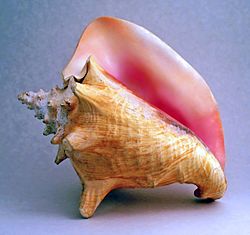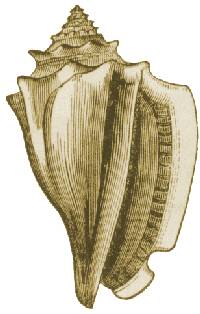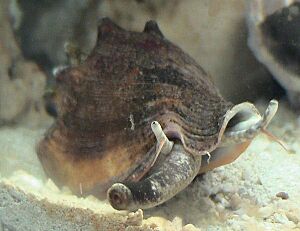Conch facts for kids
Quick facts for kids Conch |
|
|---|---|
 |
|
| An adult Queen Conch shell | |
| Scientific classification | |
| Kingdom: | |
| Phylum: | |
| Class: | |
| Superorder: |
Caenogastropoda
|
| Order: |
Sorbeoconcha
|
| Suborder: |
Hypsogastropoda
|
| Infraorder: |
Littorinimorpha
|
| Superfamily: |
Stromboidea
|
| Family: |
Strombidae
|
| Genus: |
Strombus
|
| Species | |
|
Strombus gigas |
|
A conch is a type of mollusc that lives in the sea. It's a marine snail. You can say 'conch' with a hard 'ch' sound, like in 'loch', or a soft 'ch' sound, like in 'lunch'.
Many other sea snails are called 'conch', but they aren't 'true conches'. True conches belong to a special family called Strombidae. For example, the Horse Conch is not a true conch. The group of true conches is called Strombus.
Most species of true conches are now extinct. But at least 65 species still exist today. Most of these live in the Indo-Pacific Oceans. Six species are found in the Caribbean region. Some living true conch species include the Queen Conch (Strombus gigas) and the West Indian Fighting Conch (Strombus pugilis).
Many conches, like the Queen Conch, live among beds of sea grass. They prefer warm, tropical waters. The Queen Conch (Strombus gigas) is a protected species. International trade of this conch is highly controlled. This is because it is an endangered species.
| Top - 0-9 A B C D E F G H I J K L M N O P Q R S T U V W X Y Z |
What Does a Conch Look Like?
Conches have shells that spiral. These shells can spiral either to the left (called sinistral) or to the right (called dextral). Most conch shells spiral to the right.
Conches have long eye stalks, like little periscopes. Their shell opening, called the aperture, is long and narrow. They also have a special groove near the front of their shell. This groove is called a stromboid notch.
Conches have a foot that ends in a pointed, hard, sickle-shaped part. This part is called an operculum. When conches become adults, their shells grow a wide, flared lip.
How Do Conches Move?
Conches move in a unique way. They use their pointed, sickle-shaped operculum to push themselves forward. This makes them appear to leap or hop across the seafloor.
Conches lay their eggs in long, jelly-like strands. These strands can be quite long and contain many tiny eggs.
How Do People Use Conches?
People use conches in many ways. The animal inside the shell is often eaten. It can be eaten raw in salads. Or it can be cooked in dishes like fritters, chowders, gumbos, and burgers. In some Asian foods, the meat is sliced thin and then steamed or stir-fried. Sometimes, conch meat is confused with whelk meat, which is called Scungilli.
Conch shells are also used for decoration. They can be used as planters for small plants. People also use them to make cameos, which are carved jewelry pieces. Like other mollusk shells, conch shells can be ground into a powder. This powder is used as an ingredient in making porcelain.
In ancient Mayan art, conches were used in many ways. They were paint and ink holders for important writers. They were also used as bugles or trumpets. And sometimes, they were even used as hand weapons in battles.
Today, in some countries, cleaned Queen Conch shells are sold to tourists. They are popular souvenirs or used in jewelry. However, taking these shells out of the country without a permit is against international rules. These rules are set by CITES, which protects endangered species. If you try to bring them home without a permit, you could face problems at customs. In the UK, conch shells are one of the most commonly seized items at customs.
Sometimes, conch shells are used as a building material. They can be used instead of bricks or to fill in land. It is also believed that early Caribbean natives used conch shells as weapons.
Playing the Conch Shell
Conch shells can be turned into simple bugles. To do this, a small tip of the shell is removed to create a mouthpiece. These shell instruments are used in the Pacific Islands and parts of Asia.
While they don't have the wide range of notes like brass instruments, conch shells are still interesting to play. Since there are no valves, how you shape your lips (called embouchure) is very important. Most shells naturally play only one note. But by changing your hand position inside the shell and how you blow, you can make different sounds.
Some people say the conch shell is the musical instrument of mermaids and mermen. A famous musician named Steve Turre is known for playing the shell. Conch shells have even been used in classical music. For example, in the symphony "La Noche de Los Mayas" (Night of the Mayas), which first played in 1939.
Conches in Religion
Hindu Traditions

The conch shell is very important in Hinduism. It is used as a trumpeting sound for announcements and prayers. The Hindu God of Preservation, Vishnu, holds a special conch called Panchajanya. This conch represents life coming from the life-giving waters.
In ancient India, warriors would blow conch shells to announce battles. This is famously shown at the start of the Kurukshetra war in the Mahabharata, a famous Hindu epic. The conch shell is a deep part of Hindu beliefs and traditions. Even today, many Hindus use the conch in their religious practices. They blow it during worship at certain times, along with ceremonial bells.
Buddhist Traditions
Buddhism also uses the conch in its symbols. It is one of the eight auspicious symbols in Buddhist symbolism.
Conches in Books
William Golding's famous book Lord of the Flies often talks about "The Conch". In the story, a conch shell is blown to call the boys together for meetings. Whoever holds the conch is allowed to speak. This makes the conch a symbol of democracy and order. When one of the characters, Roger, smashes the shell, it shows that civilized order has broken down. It marks the beginning of chaos and Jack's control.
Images for kids
-
A beautiful Queen Conch shell from Trinidad and Tobago.
-
A Florida crown conch shell that a hermit crab has made its home.
-
A group of large eastern conches, also known as whelks, for sale at a seafood market.








